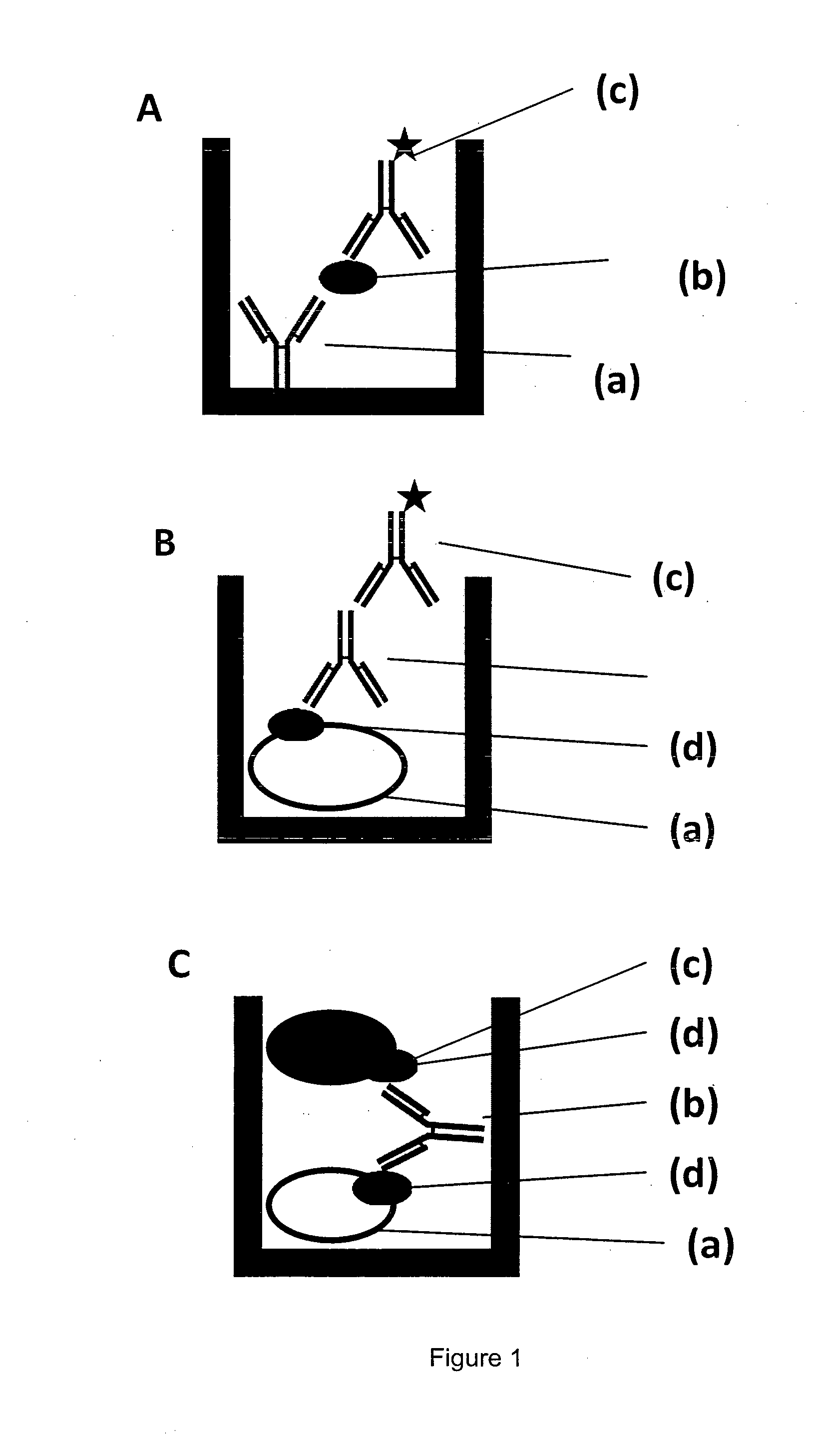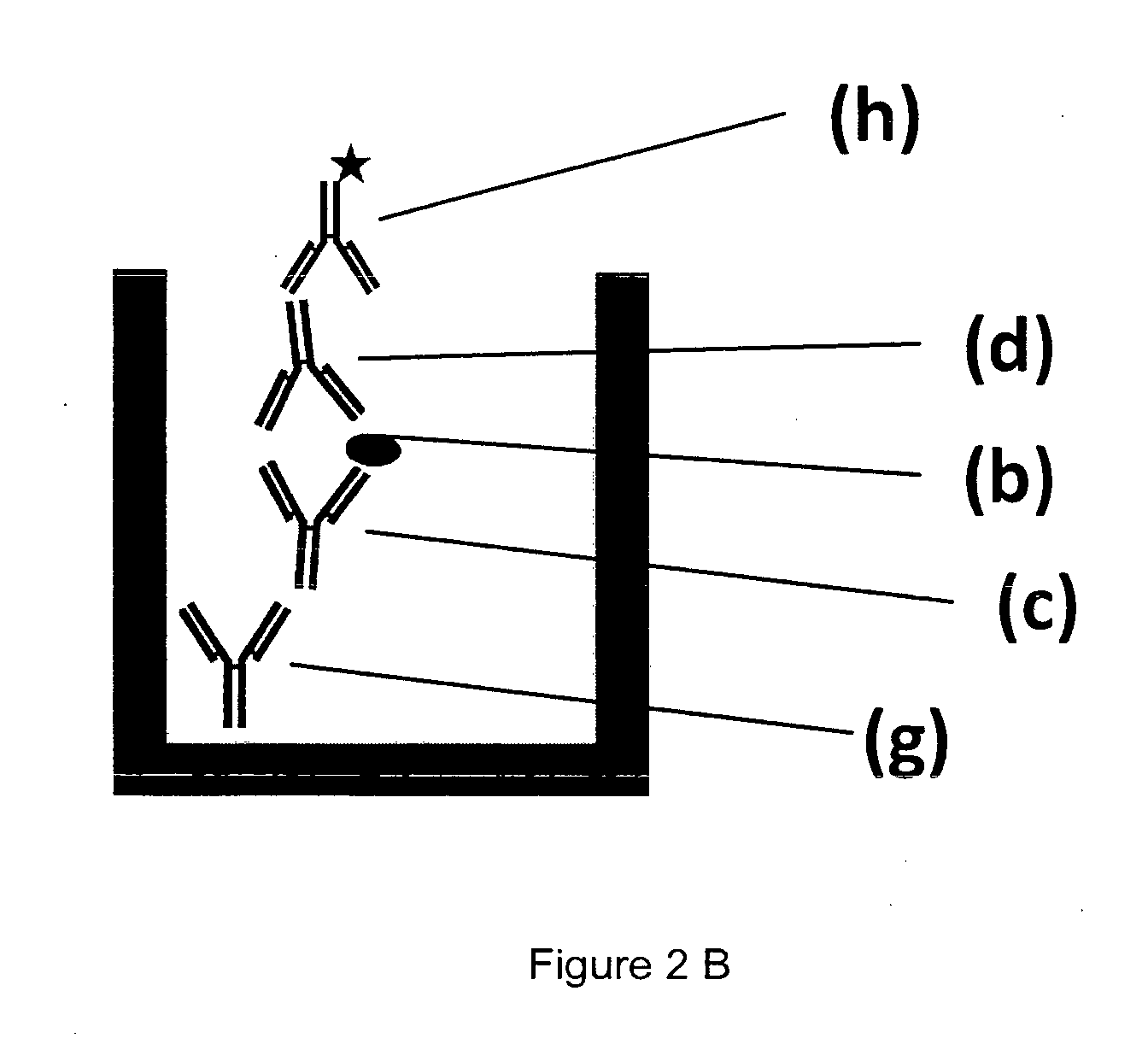Platelet Allo-Antigen Typing And Platelet Antibody Tests
a technology of which is applied in the field of platelet alloantigen typing and platelet antibody tests, can solve the problems of lack of suitable diagnostic tests, lack of widespread use of approaches, and lack of suitable results
- Summary
- Abstract
- Description
- Claims
- Application Information
AI Technical Summary
Benefits of technology
Problems solved by technology
Method used
Image
Examples
example 1
[0211]An HPA-1 a evanescence biosensor test is performed by reacting an anti-gpllbllla antibody coated surface (anti-gpllbllla monoclonal antibody RFGP56), one part of EDTA anti-coagulated blood and two parts of a detection mixture containing the anti HPA-1 a specific antibody conjugated to Allo-phycocyanin (APC).
[0212]An evanescence biosensor chip is coated with a solution of RFGP56 in PBS. Coating is done by diluting the RFGP56 stock solution to a 10 microgram per milliliter solution in PBS, adding 30 microliters of this solution to each well and incubating for 2 hours at room temperature. The coating solution is then removed, the well is washed 3 times with PBS and finally 50 microliters of blocking solution is added to the well. The blocking solution is a 1% solution of BSA in PBS and contains 0.25% TWEEN 20. Blocking is for approximately 1 hour at room temperature and is terminated by removing the blocking solution and adding the sample solution to be measure...
example 2
[0216]A simple HPA-5b typing assay with the evanescence biosensor system according to the present invention is performed by reacting an anti-gplalla antibody coated surface (anti-gplalla monoclonal antibody AK7), one part of ETDA anti-coagulated blood and two parts of a detection mixture containing an anti HPA-5b specific antibody conjugated to Allo-phycocyanin (APC). Methods and buffers were the same as in example 1 for HPA-1a typing.
[0217]More than 100 blood samples with known phenotypes for HPA 5a and 5b were tested and the results are shown in FIG. 4. There is a clear separation of HPA-5aa negative platelets and HPA-5ab positive platelets. No discrepancy between known phenotype and result obtained with the evanescence biosensor assay was observed. Tests with HPA-5bb, and HPA5aa platelets confirm the specificity of the assay.
example 3
MAIPA Assay Using Evanescence Detection
[0218]A MAIPA assay has a cellular assay part sensitizing platelets with anti-glycoprotein antibodies and the antibody from human plasma or serum to be detected as sketched in FIG. 2A, and a detection part shown in FIG. 2B.
[0219]Platelet (a) with the platelet glycoprotein (b) are reacted with a monoclonal antibody (c) directed against the platelet glycoprotein under examination. Typically, four reactions for four different glycoproteins are done with monoclonal antibodies against gpllbllla, gplalla, gplbIX and HLA / beta-2-microglobulin. After the complex is formed by interaction of (b) and (c), the human plasma or serum sample to be analyzed (e) is added and binding of the human anti-HPA antibody (d) occurs, leaving behind the serum with a reduced or depleted anti-platelet antibody (f). Excess human plasma is washed off manually. Using a detergent containing lysis buffer, the tri-molecular complex made of glycoprotein specific antibody (c), plat...
PUM
| Property | Measurement | Unit |
|---|---|---|
| volume | aaaaa | aaaaa |
| volume | aaaaa | aaaaa |
| volume | aaaaa | aaaaa |
Abstract
Description
Claims
Application Information
 Login to View More
Login to View More - R&D Engineer
- R&D Manager
- IP Professional
- Industry Leading Data Capabilities
- Powerful AI technology
- Patent DNA Extraction
Browse by: Latest US Patents, China's latest patents, Technical Efficacy Thesaurus, Application Domain, Technology Topic, Popular Technical Reports.
© 2024 PatSnap. All rights reserved.Legal|Privacy policy|Modern Slavery Act Transparency Statement|Sitemap|About US| Contact US: help@patsnap.com










